Business and the Business Environment Report: Analysis of Firms
VerifiedAdded on 2022/12/15
|18
|5544
|238
Report
AI Summary
This report provides a comprehensive analysis of the business environment, exploring various organizational types and their purposes, including private and public limited companies, sole proprietorships, and voluntary organizations like Oxfam and NHS. It examines the sizes and scopes of businesses such as John Lewis and NHS, detailing their missions, visions, and product offerings. The report further investigates the interrelationships between different organizational functions, such as marketing, finance, human resources, sales, and production, and their links to organizational objectives. It also assesses the positive and negative impacts of the macro environment on businesses, utilizing the PESTLE model and SWOT analysis to evaluate the strengths and weaknesses of Sainsbury's and Tesco, considering both internal and external factors and their interrelations. The report concludes with an evaluation of the strategic implications of these analyses, offering insights into business operations and decision-making.
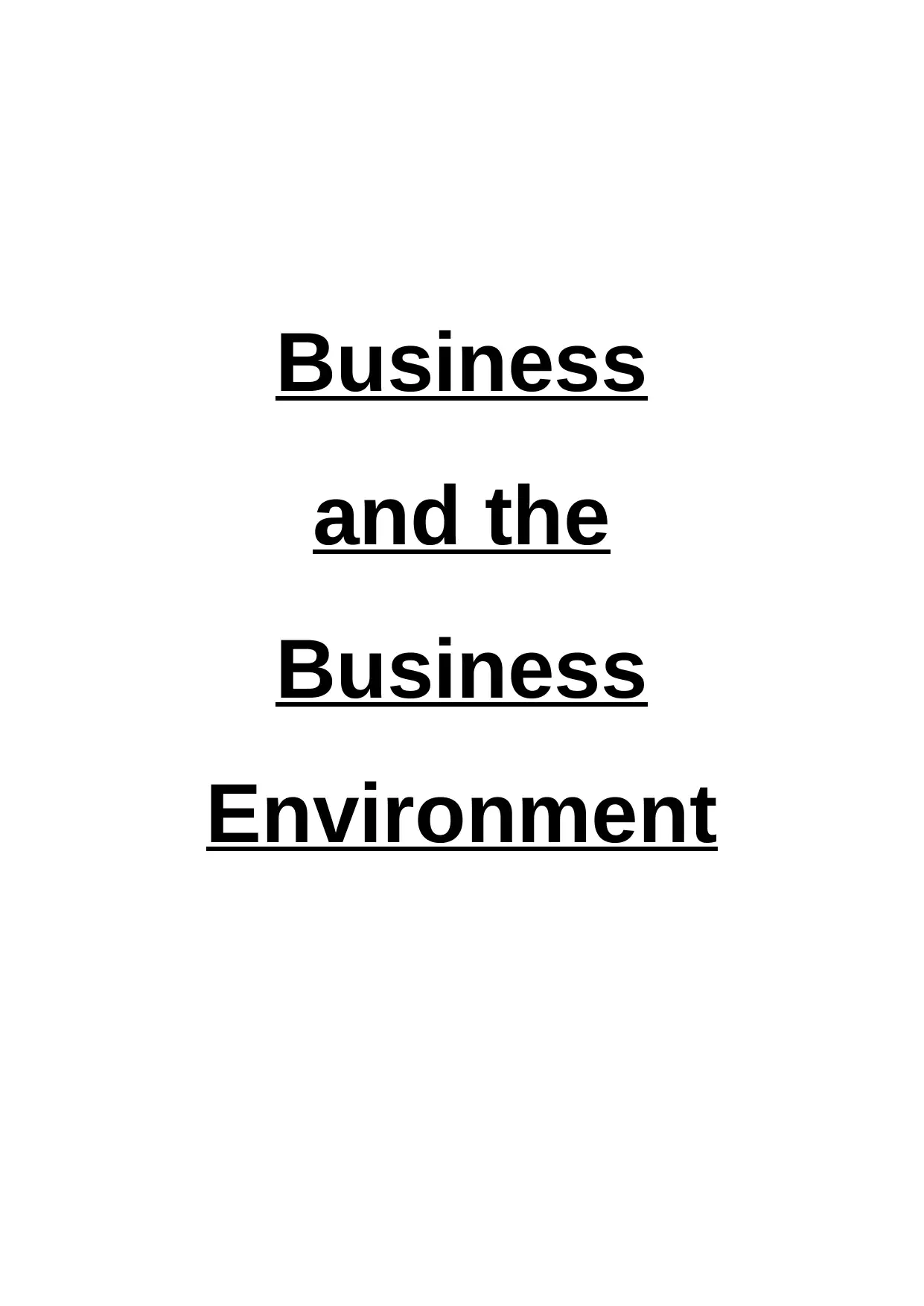
Business
and the
Business
Environment
and the
Business
Environment
Paraphrase This Document
Need a fresh take? Get an instant paraphrase of this document with our AI Paraphraser
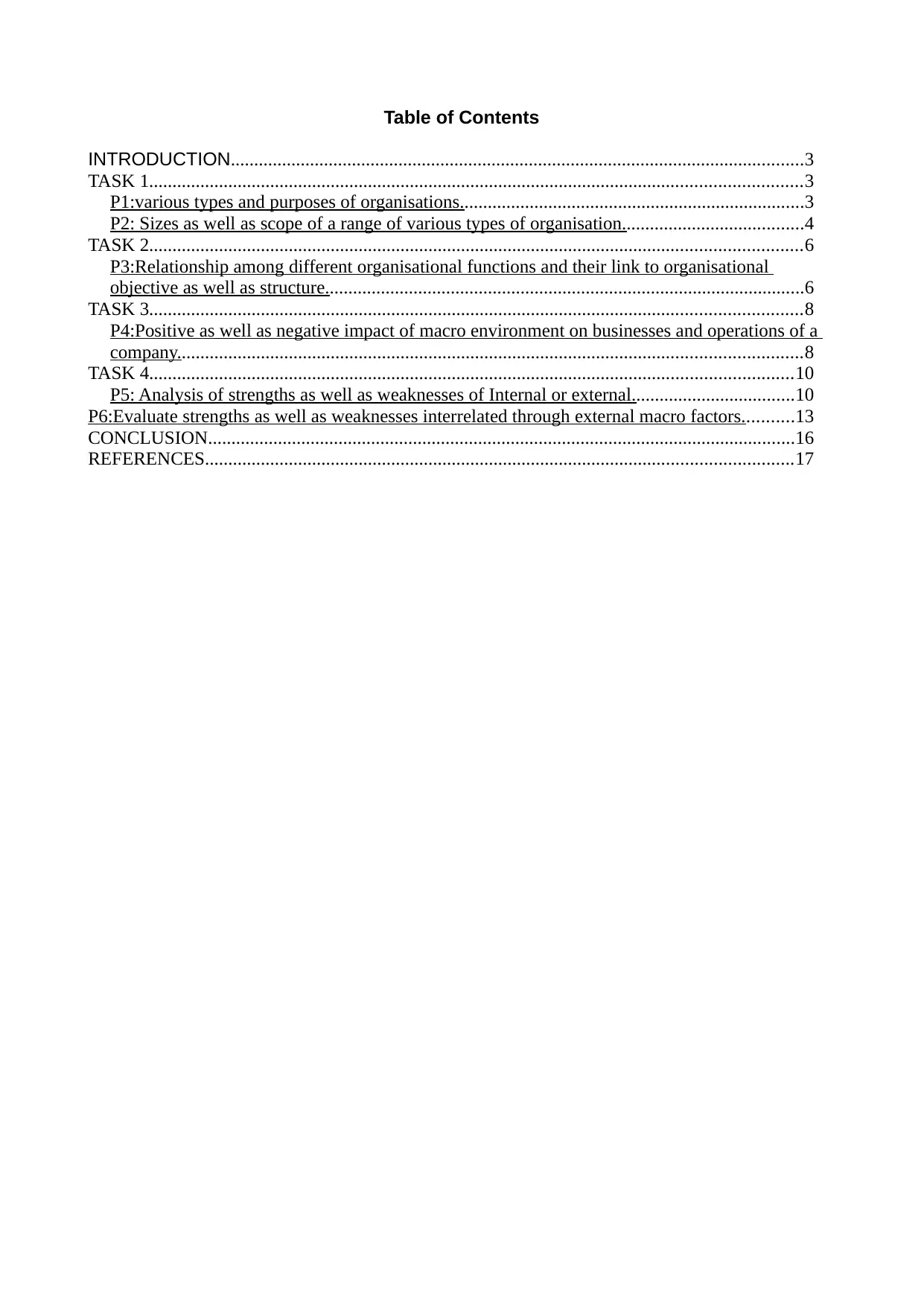
Table of Contents
INTRODUCTION...........................................................................................................................3
TASK 1............................................................................................................................................3
P1:various types and purposes of organisations..........................................................................3
P2: Sizes as well as scope of a range of various types of organisation.......................................4
TASK 2............................................................................................................................................6
P3:Relationship among different organisational functions and their link to organisational
objective as well as structure.......................................................................................................6
TASK 3............................................................................................................................................8
P4:Positive as well as negative impact of macro environment on businesses and operations of a
company......................................................................................................................................8
TASK 4..........................................................................................................................................10
P5: Analysis of strengths as well as weaknesses of Internal or external...................................10
P6:Evaluate strengths as well as weaknesses interrelated through external macro factors...........13
CONCLUSION..............................................................................................................................16
REFERENCES..............................................................................................................................17
INTRODUCTION...........................................................................................................................3
TASK 1............................................................................................................................................3
P1:various types and purposes of organisations..........................................................................3
P2: Sizes as well as scope of a range of various types of organisation.......................................4
TASK 2............................................................................................................................................6
P3:Relationship among different organisational functions and their link to organisational
objective as well as structure.......................................................................................................6
TASK 3............................................................................................................................................8
P4:Positive as well as negative impact of macro environment on businesses and operations of a
company......................................................................................................................................8
TASK 4..........................................................................................................................................10
P5: Analysis of strengths as well as weaknesses of Internal or external...................................10
P6:Evaluate strengths as well as weaknesses interrelated through external macro factors...........13
CONCLUSION..............................................................................................................................16
REFERENCES..............................................................................................................................17
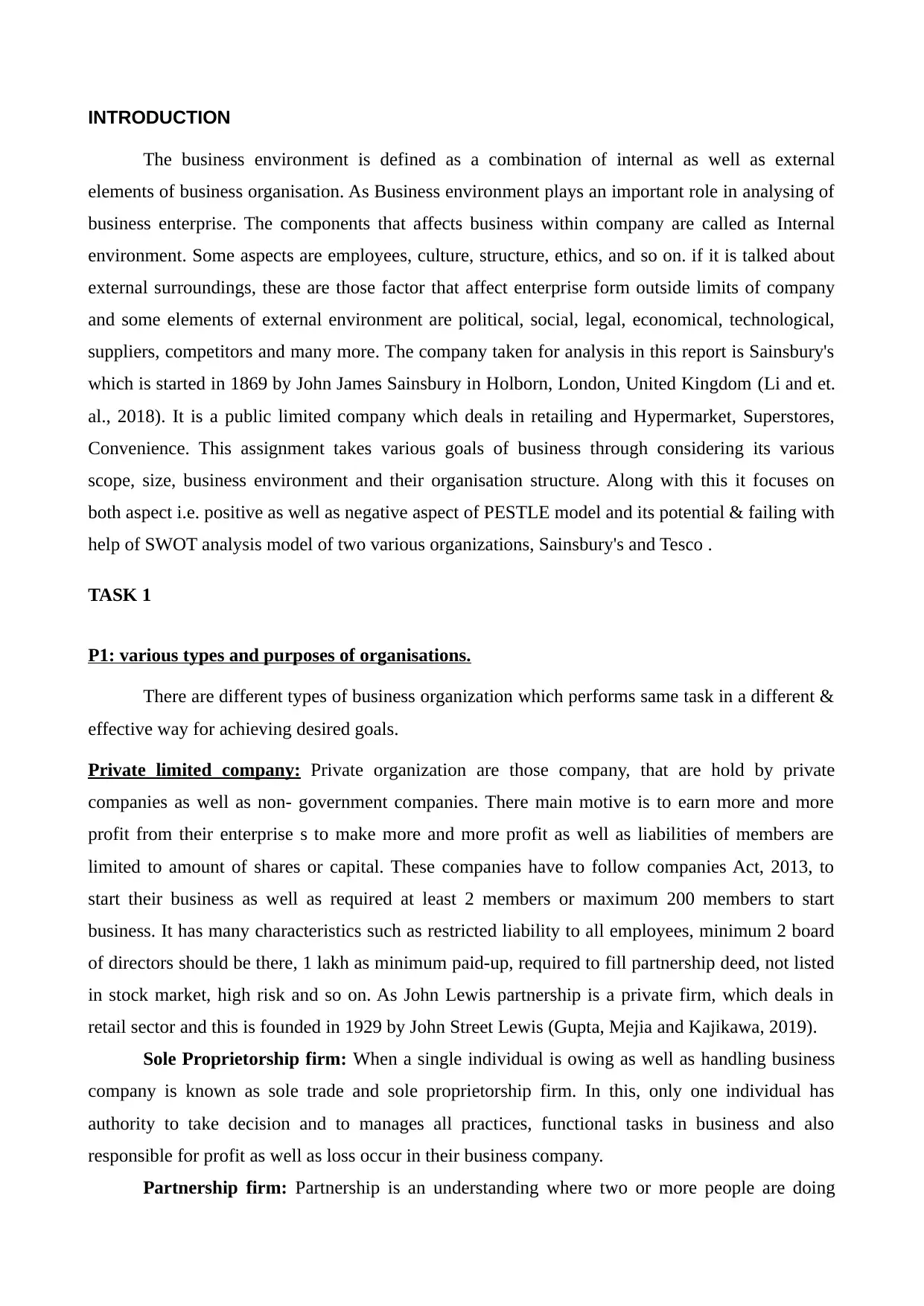
INTRODUCTION
The business environment is defined as a combination of internal as well as external
elements of business organisation. As Business environment plays an important role in analysing of
business enterprise. The components that affects business within company are called as Internal
environment. Some aspects are employees, culture, structure, ethics, and so on. if it is talked about
external surroundings, these are those factor that affect enterprise form outside limits of company
and some elements of external environment are political, social, legal, economical, technological,
suppliers, competitors and many more. The company taken for analysis in this report is Sainsbury's
which is started in 1869 by John James Sainsbury in Holborn, London, United Kingdom (Li and et.
al., 2018). It is a public limited company which deals in retailing and Hypermarket, Superstores,
Convenience. This assignment takes various goals of business through considering its various
scope, size, business environment and their organisation structure. Along with this it focuses on
both aspect i.e. positive as well as negative aspect of PESTLE model and its potential & failing with
help of SWOT analysis model of two various organizations, Sainsbury's and Tesco .
TASK 1
P1: various types and purposes of organisations.
There are different types of business organization which performs same task in a different &
effective way for achieving desired goals.
Private limited company: Private organization are those company, that are hold by private
companies as well as non- government companies. There main motive is to earn more and more
profit from their enterprise s to make more and more profit as well as liabilities of members are
limited to amount of shares or capital. These companies have to follow companies Act, 2013, to
start their business as well as required at least 2 members or maximum 200 members to start
business. It has many characteristics such as restricted liability to all employees, minimum 2 board
of directors should be there, 1 lakh as minimum paid-up, required to fill partnership deed, not listed
in stock market, high risk and so on. As John Lewis partnership is a private firm, which deals in
retail sector and this is founded in 1929 by John Street Lewis (Gupta, Mejia and Kajikawa, 2019).
Sole Proprietorship firm: When a single individual is owing as well as handling business
company is known as sole trade and sole proprietorship firm. In this, only one individual has
authority to take decision and to manages all practices, functional tasks in business and also
responsible for profit as well as loss occur in their business company.
Partnership firm: Partnership is an understanding where two or more people are doing
The business environment is defined as a combination of internal as well as external
elements of business organisation. As Business environment plays an important role in analysing of
business enterprise. The components that affects business within company are called as Internal
environment. Some aspects are employees, culture, structure, ethics, and so on. if it is talked about
external surroundings, these are those factor that affect enterprise form outside limits of company
and some elements of external environment are political, social, legal, economical, technological,
suppliers, competitors and many more. The company taken for analysis in this report is Sainsbury's
which is started in 1869 by John James Sainsbury in Holborn, London, United Kingdom (Li and et.
al., 2018). It is a public limited company which deals in retailing and Hypermarket, Superstores,
Convenience. This assignment takes various goals of business through considering its various
scope, size, business environment and their organisation structure. Along with this it focuses on
both aspect i.e. positive as well as negative aspect of PESTLE model and its potential & failing with
help of SWOT analysis model of two various organizations, Sainsbury's and Tesco .
TASK 1
P1: various types and purposes of organisations.
There are different types of business organization which performs same task in a different &
effective way for achieving desired goals.
Private limited company: Private organization are those company, that are hold by private
companies as well as non- government companies. There main motive is to earn more and more
profit from their enterprise s to make more and more profit as well as liabilities of members are
limited to amount of shares or capital. These companies have to follow companies Act, 2013, to
start their business as well as required at least 2 members or maximum 200 members to start
business. It has many characteristics such as restricted liability to all employees, minimum 2 board
of directors should be there, 1 lakh as minimum paid-up, required to fill partnership deed, not listed
in stock market, high risk and so on. As John Lewis partnership is a private firm, which deals in
retail sector and this is founded in 1929 by John Street Lewis (Gupta, Mejia and Kajikawa, 2019).
Sole Proprietorship firm: When a single individual is owing as well as handling business
company is known as sole trade and sole proprietorship firm. In this, only one individual has
authority to take decision and to manages all practices, functional tasks in business and also
responsible for profit as well as loss occur in their business company.
Partnership firm: Partnership is an understanding where two or more people are doing
⊘ This is a preview!⊘
Do you want full access?
Subscribe today to unlock all pages.

Trusted by 1+ million students worldwide
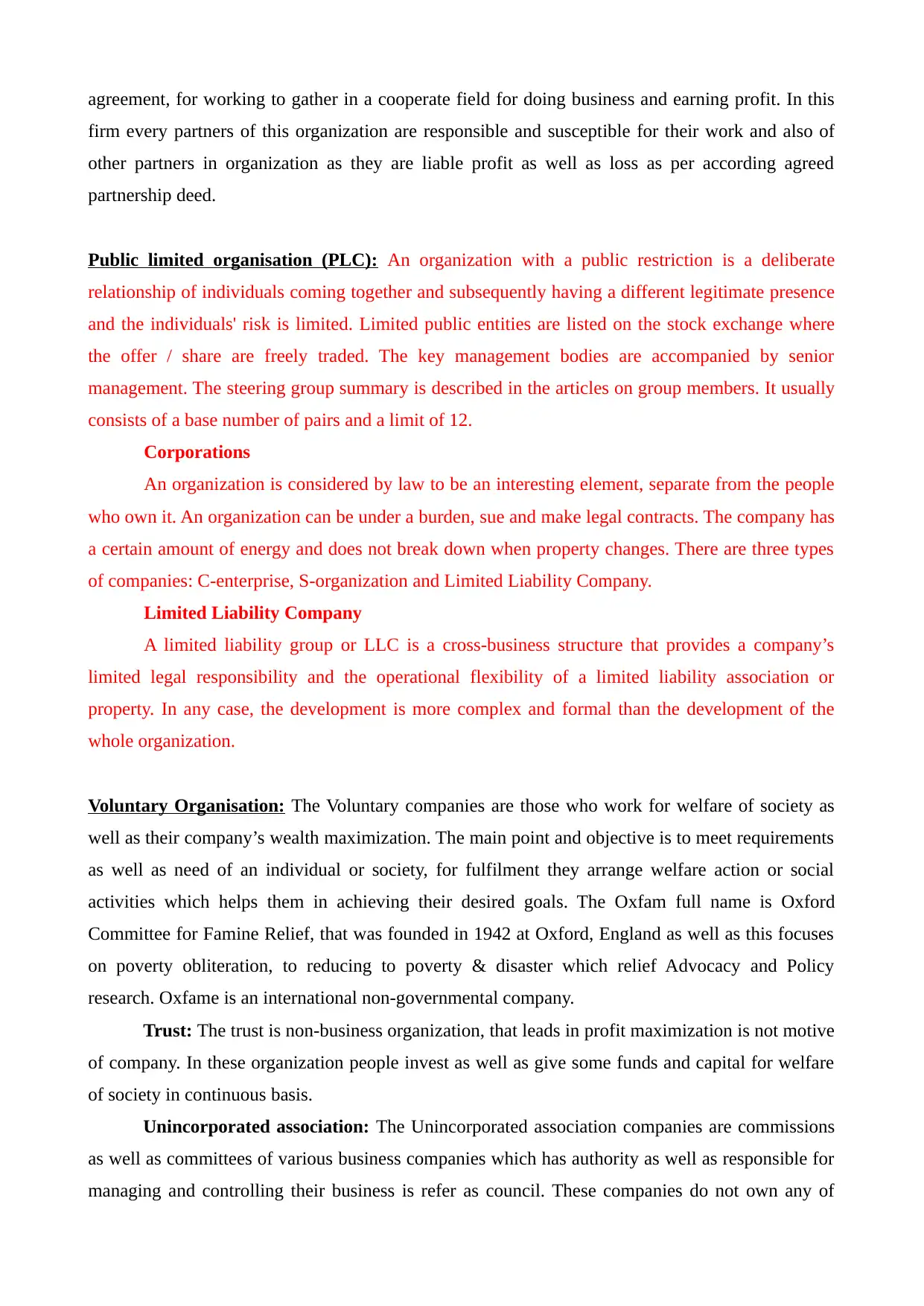
agreement, for working to gather in a cooperate field for doing business and earning profit. In this
firm every partners of this organization are responsible and susceptible for their work and also of
other partners in organization as they are liable profit as well as loss as per according agreed
partnership deed.
Public limited organisation (PLC): An organization with a public restriction is a deliberate
relationship of individuals coming together and subsequently having a different legitimate presence
and the individuals' risk is limited. Limited public entities are listed on the stock exchange where
the offer / share are freely traded. The key management bodies are accompanied by senior
management. The steering group summary is described in the articles on group members. It usually
consists of a base number of pairs and a limit of 12.
Corporations
An organization is considered by law to be an interesting element, separate from the people
who own it. An organization can be under a burden, sue and make legal contracts. The company has
a certain amount of energy and does not break down when property changes. There are three types
of companies: C-enterprise, S-organization and Limited Liability Company.
Limited Liability Company
A limited liability group or LLC is a cross-business structure that provides a company’s
limited legal responsibility and the operational flexibility of a limited liability association or
property. In any case, the development is more complex and formal than the development of the
whole organization.
Voluntary Organisation: The Voluntary companies are those who work for welfare of society as
well as their company’s wealth maximization. The main point and objective is to meet requirements
as well as need of an individual or society, for fulfilment they arrange welfare action or social
activities which helps them in achieving their desired goals. The Oxfam full name is Oxford
Committee for Famine Relief, that was founded in 1942 at Oxford, England as well as this focuses
on poverty obliteration, to reducing to poverty & disaster which relief Advocacy and Policy
research. Oxfame is an international non-governmental company.
Trust: The trust is non-business organization, that leads in profit maximization is not motive
of company. In these organization people invest as well as give some funds and capital for welfare
of society in continuous basis.
Unincorporated association: The Unincorporated association companies are commissions
as well as committees of various business companies which has authority as well as responsible for
managing and controlling their business is refer as council. These companies do not own any of
firm every partners of this organization are responsible and susceptible for their work and also of
other partners in organization as they are liable profit as well as loss as per according agreed
partnership deed.
Public limited organisation (PLC): An organization with a public restriction is a deliberate
relationship of individuals coming together and subsequently having a different legitimate presence
and the individuals' risk is limited. Limited public entities are listed on the stock exchange where
the offer / share are freely traded. The key management bodies are accompanied by senior
management. The steering group summary is described in the articles on group members. It usually
consists of a base number of pairs and a limit of 12.
Corporations
An organization is considered by law to be an interesting element, separate from the people
who own it. An organization can be under a burden, sue and make legal contracts. The company has
a certain amount of energy and does not break down when property changes. There are three types
of companies: C-enterprise, S-organization and Limited Liability Company.
Limited Liability Company
A limited liability group or LLC is a cross-business structure that provides a company’s
limited legal responsibility and the operational flexibility of a limited liability association or
property. In any case, the development is more complex and formal than the development of the
whole organization.
Voluntary Organisation: The Voluntary companies are those who work for welfare of society as
well as their company’s wealth maximization. The main point and objective is to meet requirements
as well as need of an individual or society, for fulfilment they arrange welfare action or social
activities which helps them in achieving their desired goals. The Oxfam full name is Oxford
Committee for Famine Relief, that was founded in 1942 at Oxford, England as well as this focuses
on poverty obliteration, to reducing to poverty & disaster which relief Advocacy and Policy
research. Oxfame is an international non-governmental company.
Trust: The trust is non-business organization, that leads in profit maximization is not motive
of company. In these organization people invest as well as give some funds and capital for welfare
of society in continuous basis.
Unincorporated association: The Unincorporated association companies are commissions
as well as committees of various business companies which has authority as well as responsible for
managing and controlling their business is refer as council. These companies do not own any of
Paraphrase This Document
Need a fresh take? Get an instant paraphrase of this document with our AI Paraphraser
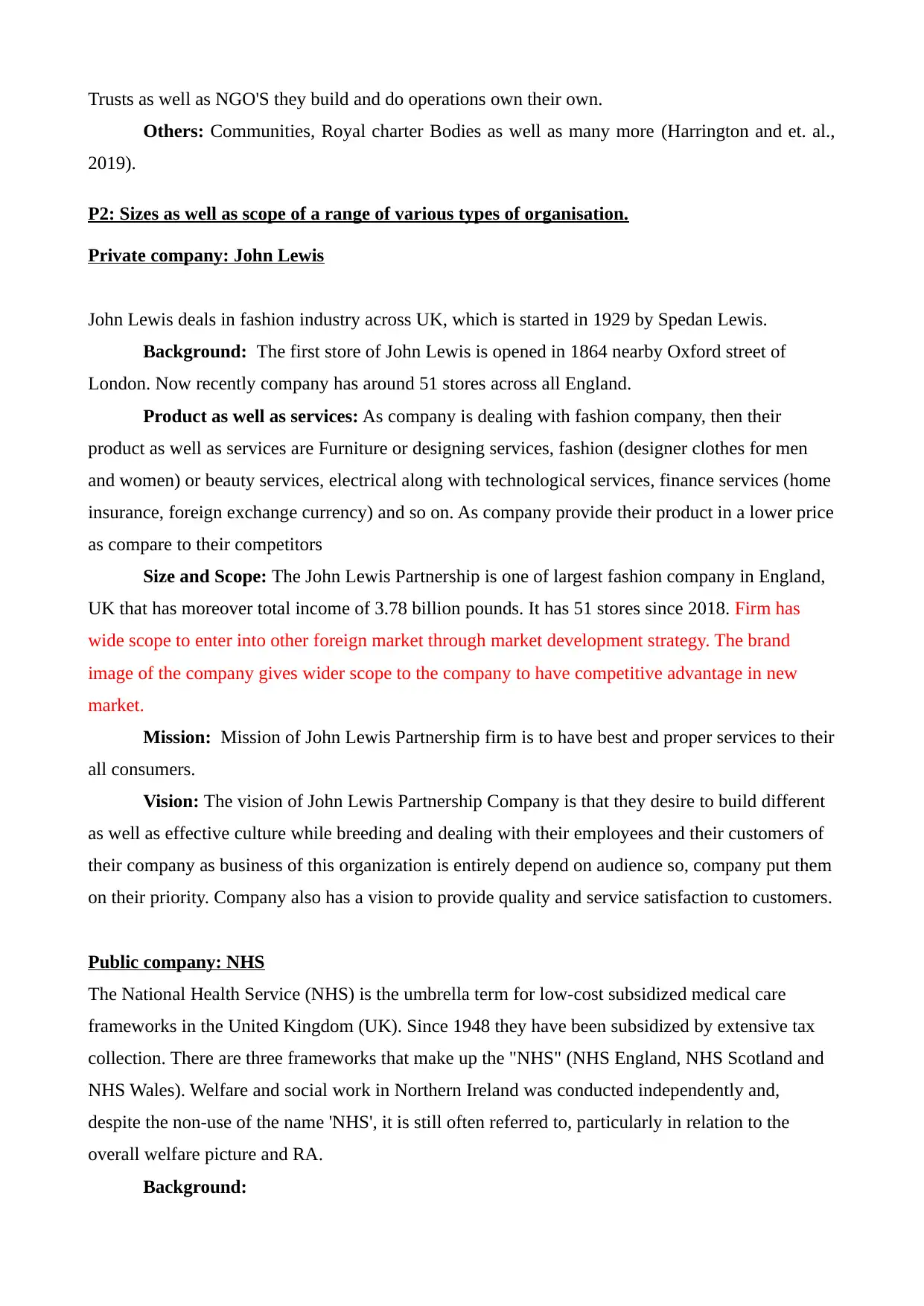
Trusts as well as NGO'S they build and do operations own their own.
Others: Communities, Royal charter Bodies as well as many more (Harrington and et. al.,
2019).
P2: Sizes as well as scope of a range of various types of organisation.
Private company: John Lewis
John Lewis deals in fashion industry across UK, which is started in 1929 by Spedan Lewis.
Background: The first store of John Lewis is opened in 1864 nearby Oxford street of
London. Now recently company has around 51 stores across all England.
Product as well as services: As company is dealing with fashion company, then their
product as well as services are Furniture or designing services, fashion (designer clothes for men
and women) or beauty services, electrical along with technological services, finance services (home
insurance, foreign exchange currency) and so on. As company provide their product in a lower price
as compare to their competitors
Size and Scope: The John Lewis Partnership is one of largest fashion company in England,
UK that has moreover total income of 3.78 billion pounds. It has 51 stores since 2018. Firm has
wide scope to enter into other foreign market through market development strategy. The brand
image of the company gives wider scope to the company to have competitive advantage in new
market.
Mission: Mission of John Lewis Partnership firm is to have best and proper services to their
all consumers.
Vision: The vision of John Lewis Partnership Company is that they desire to build different
as well as effective culture while breeding and dealing with their employees and their customers of
their company as business of this organization is entirely depend on audience so, company put them
on their priority. Company also has a vision to provide quality and service satisfaction to customers.
Public company: NHS
The National Health Service (NHS) is the umbrella term for low-cost subsidized medical care
frameworks in the United Kingdom (UK). Since 1948 they have been subsidized by extensive tax
collection. There are three frameworks that make up the "NHS" (NHS England, NHS Scotland and
NHS Wales). Welfare and social work in Northern Ireland was conducted independently and,
despite the non-use of the name 'NHS', it is still often referred to, particularly in relation to the
overall welfare picture and RA.
Background:
Others: Communities, Royal charter Bodies as well as many more (Harrington and et. al.,
2019).
P2: Sizes as well as scope of a range of various types of organisation.
Private company: John Lewis
John Lewis deals in fashion industry across UK, which is started in 1929 by Spedan Lewis.
Background: The first store of John Lewis is opened in 1864 nearby Oxford street of
London. Now recently company has around 51 stores across all England.
Product as well as services: As company is dealing with fashion company, then their
product as well as services are Furniture or designing services, fashion (designer clothes for men
and women) or beauty services, electrical along with technological services, finance services (home
insurance, foreign exchange currency) and so on. As company provide their product in a lower price
as compare to their competitors
Size and Scope: The John Lewis Partnership is one of largest fashion company in England,
UK that has moreover total income of 3.78 billion pounds. It has 51 stores since 2018. Firm has
wide scope to enter into other foreign market through market development strategy. The brand
image of the company gives wider scope to the company to have competitive advantage in new
market.
Mission: Mission of John Lewis Partnership firm is to have best and proper services to their
all consumers.
Vision: The vision of John Lewis Partnership Company is that they desire to build different
as well as effective culture while breeding and dealing with their employees and their customers of
their company as business of this organization is entirely depend on audience so, company put them
on their priority. Company also has a vision to provide quality and service satisfaction to customers.
Public company: NHS
The National Health Service (NHS) is the umbrella term for low-cost subsidized medical care
frameworks in the United Kingdom (UK). Since 1948 they have been subsidized by extensive tax
collection. There are three frameworks that make up the "NHS" (NHS England, NHS Scotland and
NHS Wales). Welfare and social work in Northern Ireland was conducted independently and,
despite the non-use of the name 'NHS', it is still often referred to, particularly in relation to the
overall welfare picture and RA.
Background:
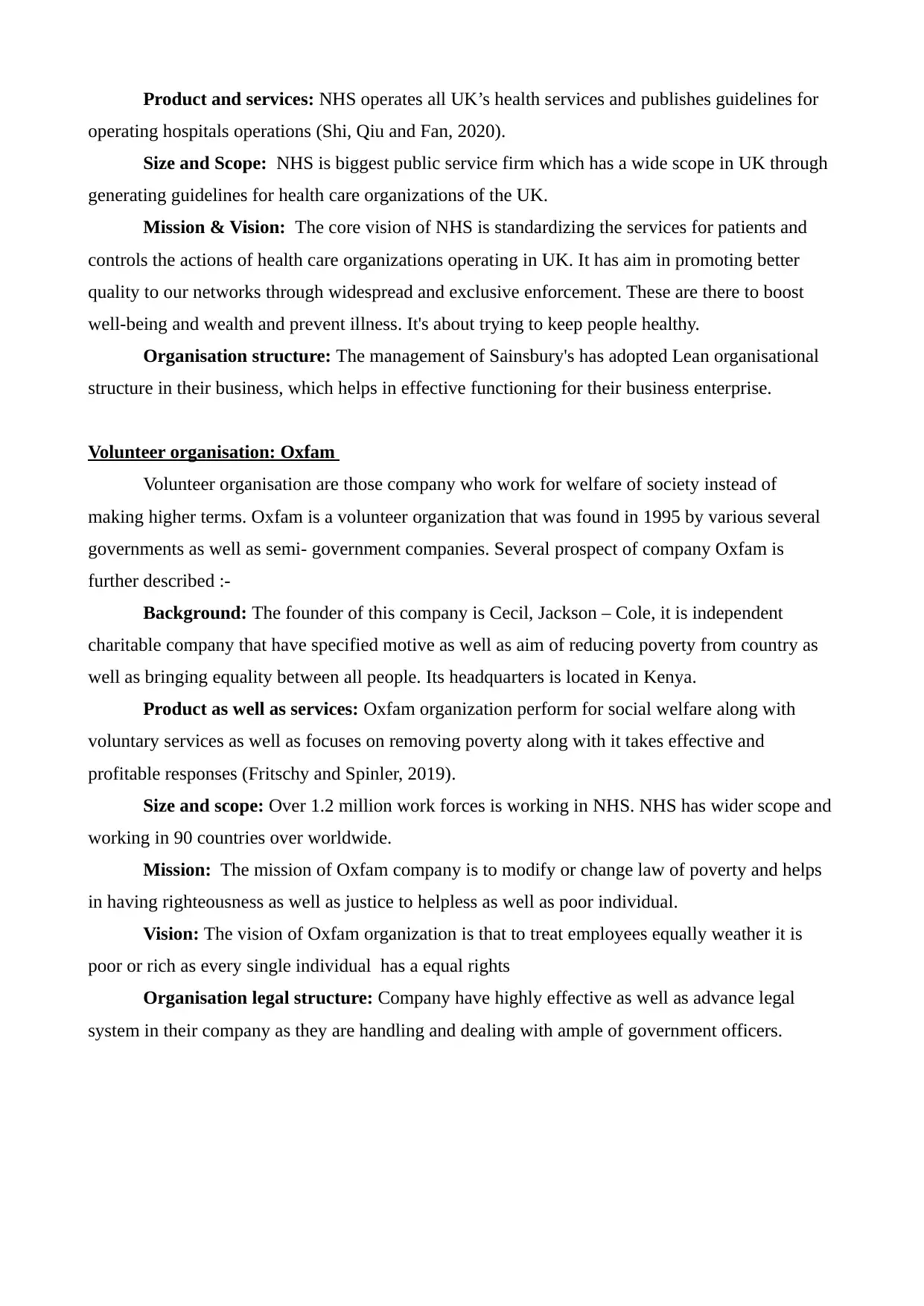
Product and services: NHS operates all UK’s health services and publishes guidelines for
operating hospitals operations (Shi, Qiu and Fan, 2020).
Size and Scope: NHS is biggest public service firm which has a wide scope in UK through
generating guidelines for health care organizations of the UK.
Mission & Vision: The core vision of NHS is standardizing the services for patients and
controls the actions of health care organizations operating in UK. It has aim in promoting better
quality to our networks through widespread and exclusive enforcement. These are there to boost
well-being and wealth and prevent illness. It's about trying to keep people healthy.
Organisation structure: The management of Sainsbury's has adopted Lean organisational
structure in their business, which helps in effective functioning for their business enterprise.
Volunteer organisation: Oxfam
Volunteer organisation are those company who work for welfare of society instead of
making higher terms. Oxfam is a volunteer organization that was found in 1995 by various several
governments as well as semi- government companies. Several prospect of company Oxfam is
further described :-
Background: The founder of this company is Cecil, Jackson – Cole, it is independent
charitable company that have specified motive as well as aim of reducing poverty from country as
well as bringing equality between all people. Its headquarters is located in Kenya.
Product as well as services: Oxfam organization perform for social welfare along with
voluntary services as well as focuses on removing poverty along with it takes effective and
profitable responses (Fritschy and Spinler, 2019).
Size and scope: Over 1.2 million work forces is working in NHS. NHS has wider scope and
working in 90 countries over worldwide.
Mission: The mission of Oxfam company is to modify or change law of poverty and helps
in having righteousness as well as justice to helpless as well as poor individual.
Vision: The vision of Oxfam organization is that to treat employees equally weather it is
poor or rich as every single individual has a equal rights
Organisation legal structure: Company have highly effective as well as advance legal
system in their company as they are handling and dealing with ample of government officers.
operating hospitals operations (Shi, Qiu and Fan, 2020).
Size and Scope: NHS is biggest public service firm which has a wide scope in UK through
generating guidelines for health care organizations of the UK.
Mission & Vision: The core vision of NHS is standardizing the services for patients and
controls the actions of health care organizations operating in UK. It has aim in promoting better
quality to our networks through widespread and exclusive enforcement. These are there to boost
well-being and wealth and prevent illness. It's about trying to keep people healthy.
Organisation structure: The management of Sainsbury's has adopted Lean organisational
structure in their business, which helps in effective functioning for their business enterprise.
Volunteer organisation: Oxfam
Volunteer organisation are those company who work for welfare of society instead of
making higher terms. Oxfam is a volunteer organization that was found in 1995 by various several
governments as well as semi- government companies. Several prospect of company Oxfam is
further described :-
Background: The founder of this company is Cecil, Jackson – Cole, it is independent
charitable company that have specified motive as well as aim of reducing poverty from country as
well as bringing equality between all people. Its headquarters is located in Kenya.
Product as well as services: Oxfam organization perform for social welfare along with
voluntary services as well as focuses on removing poverty along with it takes effective and
profitable responses (Fritschy and Spinler, 2019).
Size and scope: Over 1.2 million work forces is working in NHS. NHS has wider scope and
working in 90 countries over worldwide.
Mission: The mission of Oxfam company is to modify or change law of poverty and helps
in having righteousness as well as justice to helpless as well as poor individual.
Vision: The vision of Oxfam organization is that to treat employees equally weather it is
poor or rich as every single individual has a equal rights
Organisation legal structure: Company have highly effective as well as advance legal
system in their company as they are handling and dealing with ample of government officers.
⊘ This is a preview!⊘
Do you want full access?
Subscribe today to unlock all pages.

Trusted by 1+ million students worldwide
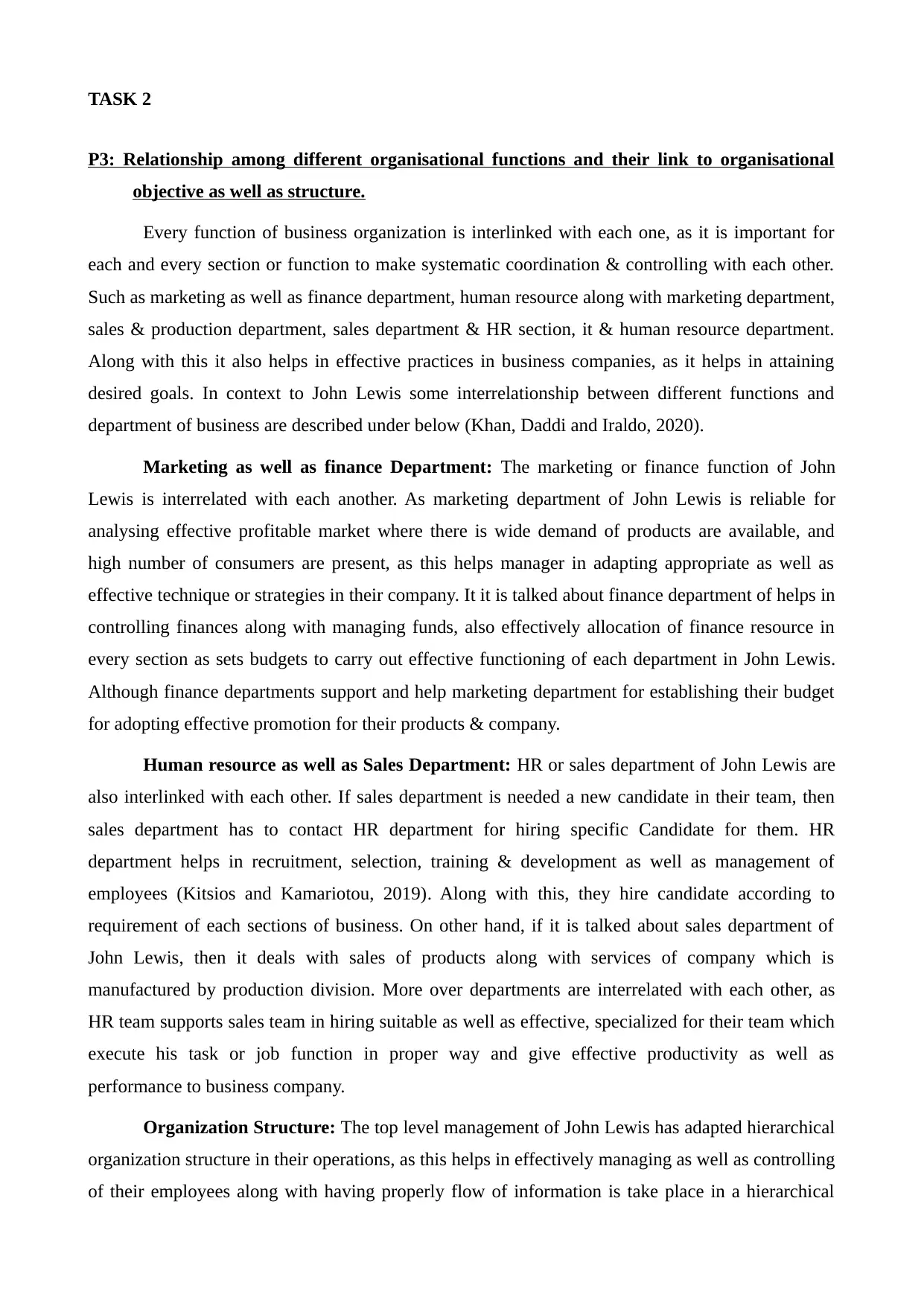
TASK 2
P3: Relationship among different organisational functions and their link to organisational
objective as well as structure.
Every function of business organization is interlinked with each one, as it is important for
each and every section or function to make systematic coordination & controlling with each other.
Such as marketing as well as finance department, human resource along with marketing department,
sales & production department, sales department & HR section, it & human resource department.
Along with this it also helps in effective practices in business companies, as it helps in attaining
desired goals. In context to John Lewis some interrelationship between different functions and
department of business are described under below (Khan, Daddi and Iraldo, 2020).
Marketing as well as finance Department: The marketing or finance function of John
Lewis is interrelated with each another. As marketing department of John Lewis is reliable for
analysing effective profitable market where there is wide demand of products are available, and
high number of consumers are present, as this helps manager in adapting appropriate as well as
effective technique or strategies in their company. It it is talked about finance department of helps in
controlling finances along with managing funds, also effectively allocation of finance resource in
every section as sets budgets to carry out effective functioning of each department in John Lewis.
Although finance departments support and help marketing department for establishing their budget
for adopting effective promotion for their products & company.
Human resource as well as Sales Department: HR or sales department of John Lewis are
also interlinked with each other. If sales department is needed a new candidate in their team, then
sales department has to contact HR department for hiring specific Candidate for them. HR
department helps in recruitment, selection, training & development as well as management of
employees (Kitsios and Kamariotou, 2019). Along with this, they hire candidate according to
requirement of each sections of business. On other hand, if it is talked about sales department of
John Lewis, then it deals with sales of products along with services of company which is
manufactured by production division. More over departments are interrelated with each other, as
HR team supports sales team in hiring suitable as well as effective, specialized for their team which
execute his task or job function in proper way and give effective productivity as well as
performance to business company.
Organization Structure: The top level management of John Lewis has adapted hierarchical
organization structure in their operations, as this helps in effectively managing as well as controlling
of their employees along with having properly flow of information is take place in a hierarchical
P3: Relationship among different organisational functions and their link to organisational
objective as well as structure.
Every function of business organization is interlinked with each one, as it is important for
each and every section or function to make systematic coordination & controlling with each other.
Such as marketing as well as finance department, human resource along with marketing department,
sales & production department, sales department & HR section, it & human resource department.
Along with this it also helps in effective practices in business companies, as it helps in attaining
desired goals. In context to John Lewis some interrelationship between different functions and
department of business are described under below (Khan, Daddi and Iraldo, 2020).
Marketing as well as finance Department: The marketing or finance function of John
Lewis is interrelated with each another. As marketing department of John Lewis is reliable for
analysing effective profitable market where there is wide demand of products are available, and
high number of consumers are present, as this helps manager in adapting appropriate as well as
effective technique or strategies in their company. It it is talked about finance department of helps in
controlling finances along with managing funds, also effectively allocation of finance resource in
every section as sets budgets to carry out effective functioning of each department in John Lewis.
Although finance departments support and help marketing department for establishing their budget
for adopting effective promotion for their products & company.
Human resource as well as Sales Department: HR or sales department of John Lewis are
also interlinked with each other. If sales department is needed a new candidate in their team, then
sales department has to contact HR department for hiring specific Candidate for them. HR
department helps in recruitment, selection, training & development as well as management of
employees (Kitsios and Kamariotou, 2019). Along with this, they hire candidate according to
requirement of each sections of business. On other hand, if it is talked about sales department of
John Lewis, then it deals with sales of products along with services of company which is
manufactured by production division. More over departments are interrelated with each other, as
HR team supports sales team in hiring suitable as well as effective, specialized for their team which
execute his task or job function in proper way and give effective productivity as well as
performance to business company.
Organization Structure: The top level management of John Lewis has adapted hierarchical
organization structure in their operations, as this helps in effectively managing as well as controlling
of their employees along with having properly flow of information is take place in a hierarchical
Paraphrase This Document
Need a fresh take? Get an instant paraphrase of this document with our AI Paraphraser
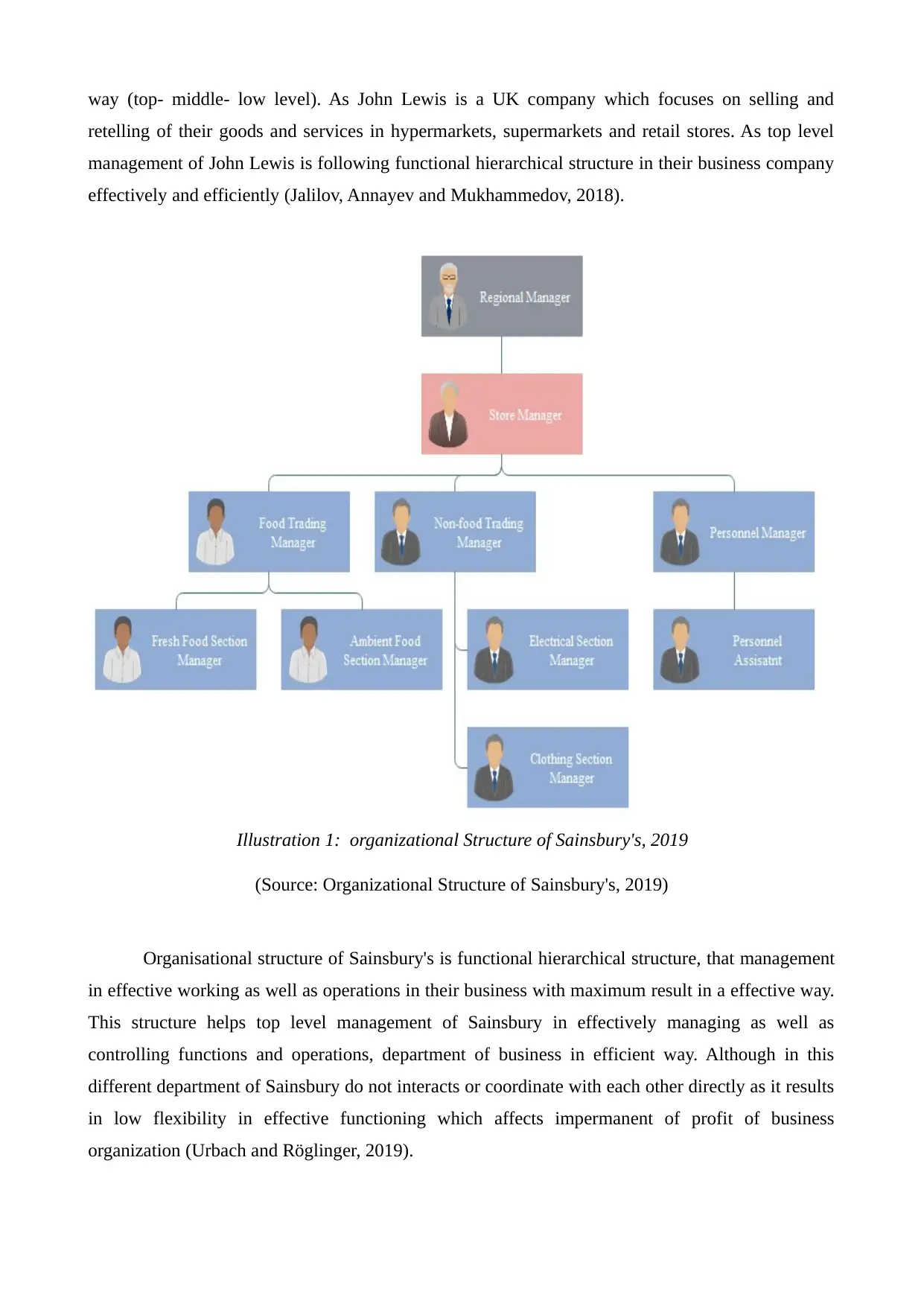
way (top- middle- low level). As John Lewis is a UK company which focuses on selling and
retelling of their goods and services in hypermarkets, supermarkets and retail stores. As top level
management of John Lewis is following functional hierarchical structure in their business company
effectively and efficiently (Jalilov, Annayev and Mukhammedov, 2018).
Illustration 1: organizational Structure of Sainsbury's, 2019
(Source: Organizational Structure of Sainsbury's, 2019)
Organisational structure of Sainsbury's is functional hierarchical structure, that management
in effective working as well as operations in their business with maximum result in a effective way.
This structure helps top level management of Sainsbury in effectively managing as well as
controlling functions and operations, department of business in efficient way. Although in this
different department of Sainsbury do not interacts or coordinate with each other directly as it results
in low flexibility in effective functioning which affects impermanent of profit of business
organization (Urbach and Röglinger, 2019).
retelling of their goods and services in hypermarkets, supermarkets and retail stores. As top level
management of John Lewis is following functional hierarchical structure in their business company
effectively and efficiently (Jalilov, Annayev and Mukhammedov, 2018).
Illustration 1: organizational Structure of Sainsbury's, 2019
(Source: Organizational Structure of Sainsbury's, 2019)
Organisational structure of Sainsbury's is functional hierarchical structure, that management
in effective working as well as operations in their business with maximum result in a effective way.
This structure helps top level management of Sainsbury in effectively managing as well as
controlling functions and operations, department of business in efficient way. Although in this
different department of Sainsbury do not interacts or coordinate with each other directly as it results
in low flexibility in effective functioning which affects impermanent of profit of business
organization (Urbach and Röglinger, 2019).

TASK 3
P4: Positive as well as negative impact of macro environment on businesses and operations of
a company.
The external surroundings of John Lewis are examined by their manager as well as analysis
that external environment PESTLE approach is dealing with both positive and negative impact.
Here impact of PESTLE is described under as below:
Basis Positive impact Negative Impact
Political factor
The political factor has positive impact
in United Kingdom that give great as
well as effective productivity and
performance of Sainsbury’s. Along
with this, when modification in
political factor give lesser impact as
compare to other it leads to positive
impact.
When changes in political factor are
not in the favour of Sainsbury's
company then it creates to negative
impact. Like as changes in political
factor, government policies, rules as
well as regulation and many more
(Joshi and Anand, 2018).
Economical
factor
The positive impact is that when
economic factors are in favour on
Sainsbury's. As company could work
on expansion of business in emerging
market and therefore it will very
beneficial for the business company
for success as well as growth.
When slowdown of economic factors
affect demand, cost, prices as well as
profit of company it leads to negative
impact to Sainsbury's. Along with
this, increase in unemployment as
well as inflation rates of food prices
results in reduce in prices ODF
Sainsbury's products.
Social factor
The positive impact of social factor is
which management of Sainsbury’s is
involved in doing welfare programs for
society like charities, raise finances for
various causes. Along with is company
is manufacturing products and services
according to taste, preferences and
natures of the customers and society
which leads to beneficial for both
The negative impact is that
Sainsbury’s, cannot creates products
and services as per to the taste of
customers always. As it leads ti
negative impact to business
organization (Śmigielska, 2018).
P4: Positive as well as negative impact of macro environment on businesses and operations of
a company.
The external surroundings of John Lewis are examined by their manager as well as analysis
that external environment PESTLE approach is dealing with both positive and negative impact.
Here impact of PESTLE is described under as below:
Basis Positive impact Negative Impact
Political factor
The political factor has positive impact
in United Kingdom that give great as
well as effective productivity and
performance of Sainsbury’s. Along
with this, when modification in
political factor give lesser impact as
compare to other it leads to positive
impact.
When changes in political factor are
not in the favour of Sainsbury's
company then it creates to negative
impact. Like as changes in political
factor, government policies, rules as
well as regulation and many more
(Joshi and Anand, 2018).
Economical
factor
The positive impact is that when
economic factors are in favour on
Sainsbury's. As company could work
on expansion of business in emerging
market and therefore it will very
beneficial for the business company
for success as well as growth.
When slowdown of economic factors
affect demand, cost, prices as well as
profit of company it leads to negative
impact to Sainsbury's. Along with
this, increase in unemployment as
well as inflation rates of food prices
results in reduce in prices ODF
Sainsbury's products.
Social factor
The positive impact of social factor is
which management of Sainsbury’s is
involved in doing welfare programs for
society like charities, raise finances for
various causes. Along with is company
is manufacturing products and services
according to taste, preferences and
natures of the customers and society
which leads to beneficial for both
The negative impact is that
Sainsbury’s, cannot creates products
and services as per to the taste of
customers always. As it leads ti
negative impact to business
organization (Śmigielska, 2018).
⊘ This is a preview!⊘
Do you want full access?
Subscribe today to unlock all pages.

Trusted by 1+ million students worldwide
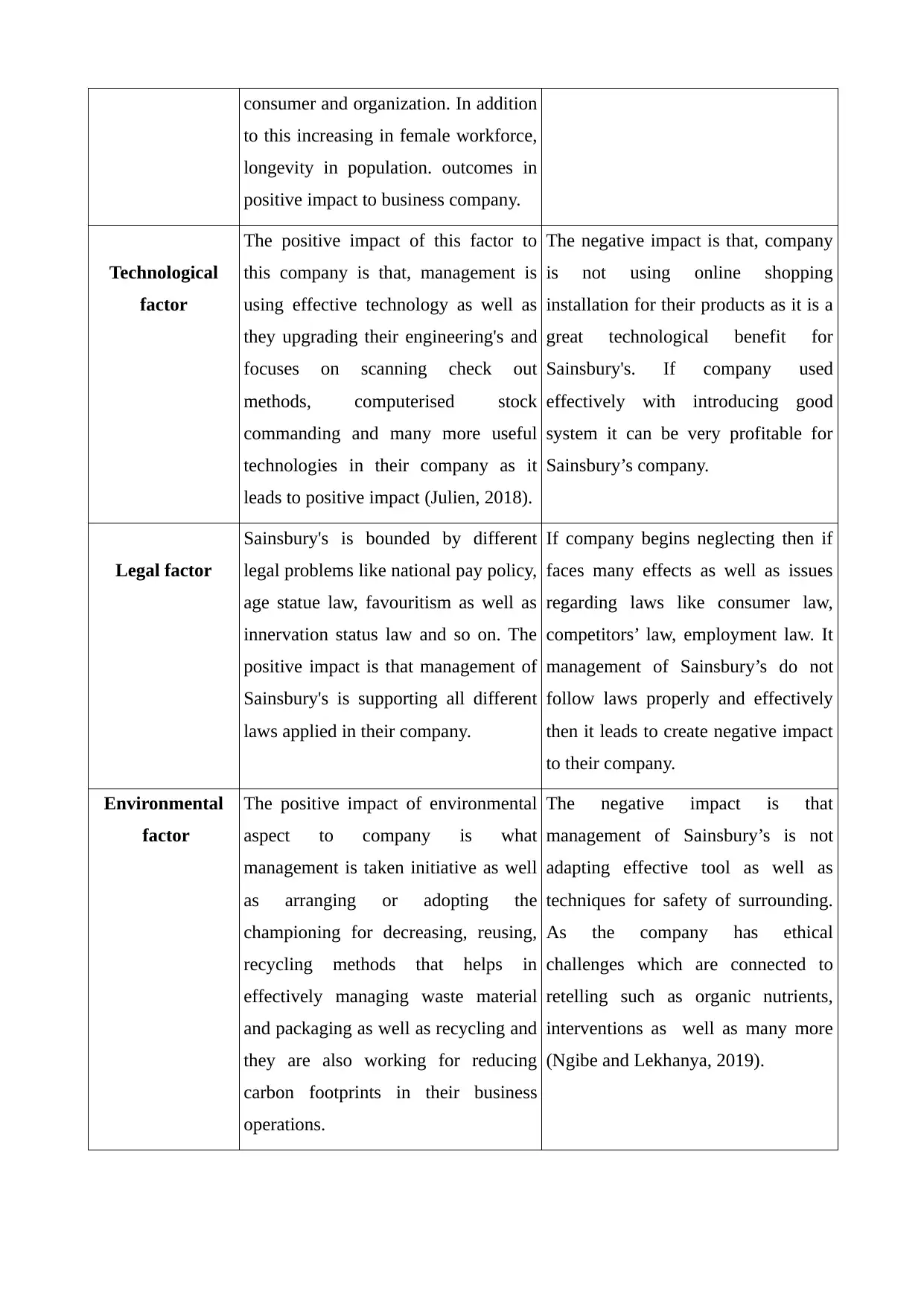
consumer and organization. In addition
to this increasing in female workforce,
longevity in population. outcomes in
positive impact to business company.
Technological
factor
The positive impact of this factor to
this company is that, management is
using effective technology as well as
they upgrading their engineering's and
focuses on scanning check out
methods, computerised stock
commanding and many more useful
technologies in their company as it
leads to positive impact (Julien, 2018).
The negative impact is that, company
is not using online shopping
installation for their products as it is a
great technological benefit for
Sainsbury's. If company used
effectively with introducing good
system it can be very profitable for
Sainsbury’s company.
Legal factor
Sainsbury's is bounded by different
legal problems like national pay policy,
age statue law, favouritism as well as
innervation status law and so on. The
positive impact is that management of
Sainsbury's is supporting all different
laws applied in their company.
If company begins neglecting then if
faces many effects as well as issues
regarding laws like consumer law,
competitors’ law, employment law. It
management of Sainsbury’s do not
follow laws properly and effectively
then it leads to create negative impact
to their company.
Environmental
factor
The positive impact of environmental
aspect to company is what
management is taken initiative as well
as arranging or adopting the
championing for decreasing, reusing,
recycling methods that helps in
effectively managing waste material
and packaging as well as recycling and
they are also working for reducing
carbon footprints in their business
operations.
The negative impact is that
management of Sainsbury’s is not
adapting effective tool as well as
techniques for safety of surrounding.
As the company has ethical
challenges which are connected to
retelling such as organic nutrients,
interventions as well as many more
(Ngibe and Lekhanya, 2019).
to this increasing in female workforce,
longevity in population. outcomes in
positive impact to business company.
Technological
factor
The positive impact of this factor to
this company is that, management is
using effective technology as well as
they upgrading their engineering's and
focuses on scanning check out
methods, computerised stock
commanding and many more useful
technologies in their company as it
leads to positive impact (Julien, 2018).
The negative impact is that, company
is not using online shopping
installation for their products as it is a
great technological benefit for
Sainsbury's. If company used
effectively with introducing good
system it can be very profitable for
Sainsbury’s company.
Legal factor
Sainsbury's is bounded by different
legal problems like national pay policy,
age statue law, favouritism as well as
innervation status law and so on. The
positive impact is that management of
Sainsbury's is supporting all different
laws applied in their company.
If company begins neglecting then if
faces many effects as well as issues
regarding laws like consumer law,
competitors’ law, employment law. It
management of Sainsbury’s do not
follow laws properly and effectively
then it leads to create negative impact
to their company.
Environmental
factor
The positive impact of environmental
aspect to company is what
management is taken initiative as well
as arranging or adopting the
championing for decreasing, reusing,
recycling methods that helps in
effectively managing waste material
and packaging as well as recycling and
they are also working for reducing
carbon footprints in their business
operations.
The negative impact is that
management of Sainsbury’s is not
adapting effective tool as well as
techniques for safety of surrounding.
As the company has ethical
challenges which are connected to
retelling such as organic nutrients,
interventions as well as many more
(Ngibe and Lekhanya, 2019).
Paraphrase This Document
Need a fresh take? Get an instant paraphrase of this document with our AI Paraphraser
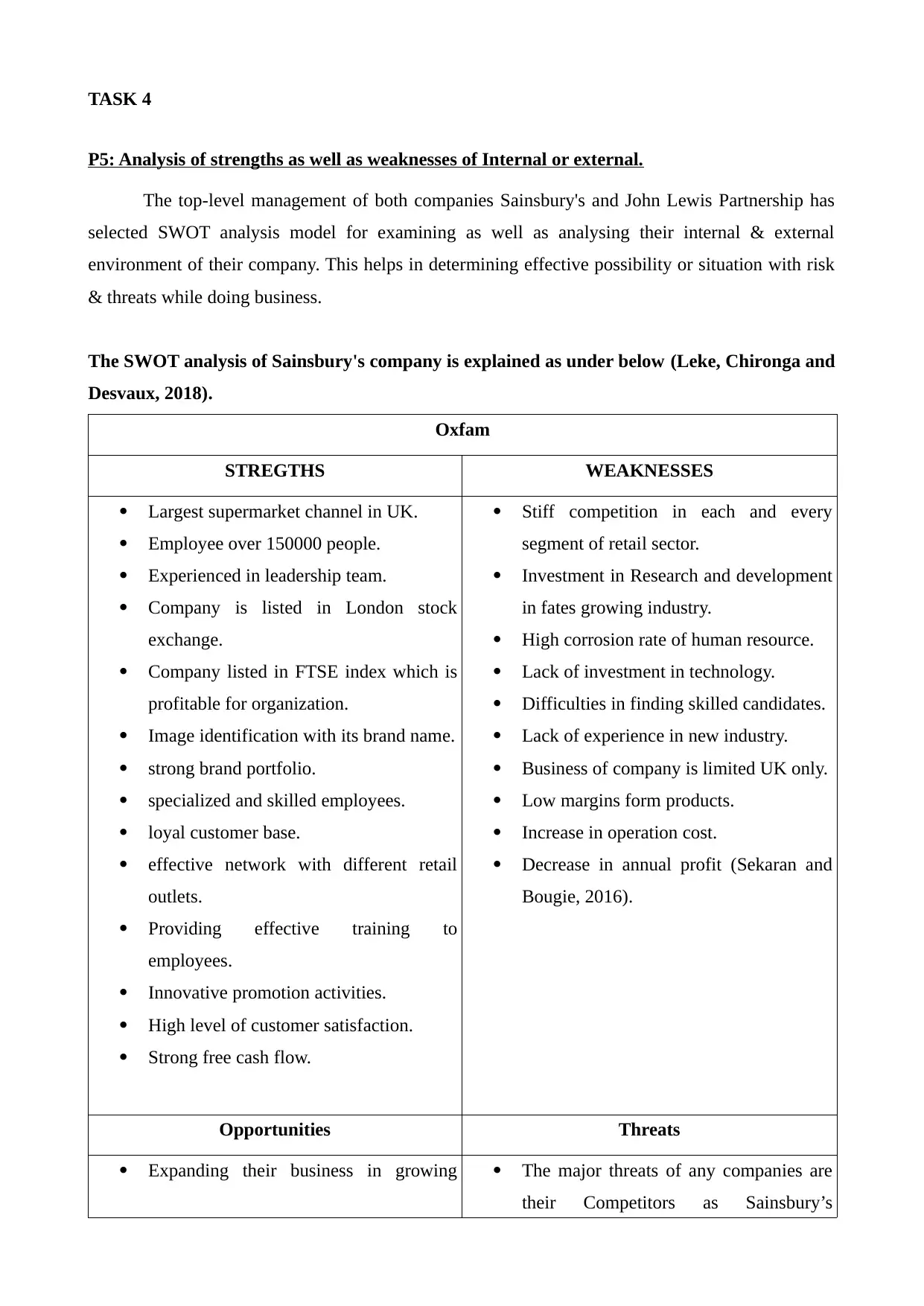
TASK 4
P5: Analysis of strengths as well as weaknesses of Internal or external.
The top-level management of both companies Sainsbury's and John Lewis Partnership has
selected SWOT analysis model for examining as well as analysing their internal & external
environment of their company. This helps in determining effective possibility or situation with risk
& threats while doing business.
The SWOT analysis of Sainsbury's company is explained as under below (Leke, Chironga and
Desvaux, 2018).
Oxfam
STREGTHS WEAKNESSES
Largest supermarket channel in UK.
Employee over 150000 people.
Experienced in leadership team.
Company is listed in London stock
exchange.
Company listed in FTSE index which is
profitable for organization.
Image identification with its brand name.
strong brand portfolio.
specialized and skilled employees.
loyal customer base.
effective network with different retail
outlets.
Providing effective training to
employees.
Innovative promotion activities.
High level of customer satisfaction.
Strong free cash flow.
Stiff competition in each and every
segment of retail sector.
Investment in Research and development
in fates growing industry.
High corrosion rate of human resource.
Lack of investment in technology.
Difficulties in finding skilled candidates.
Lack of experience in new industry.
Business of company is limited UK only.
Low margins form products.
Increase in operation cost.
Decrease in annual profit (Sekaran and
Bougie, 2016).
Opportunities Threats
Expanding their business in growing The major threats of any companies are
their Competitors as Sainsbury’s
P5: Analysis of strengths as well as weaknesses of Internal or external.
The top-level management of both companies Sainsbury's and John Lewis Partnership has
selected SWOT analysis model for examining as well as analysing their internal & external
environment of their company. This helps in determining effective possibility or situation with risk
& threats while doing business.
The SWOT analysis of Sainsbury's company is explained as under below (Leke, Chironga and
Desvaux, 2018).
Oxfam
STREGTHS WEAKNESSES
Largest supermarket channel in UK.
Employee over 150000 people.
Experienced in leadership team.
Company is listed in London stock
exchange.
Company listed in FTSE index which is
profitable for organization.
Image identification with its brand name.
strong brand portfolio.
specialized and skilled employees.
loyal customer base.
effective network with different retail
outlets.
Providing effective training to
employees.
Innovative promotion activities.
High level of customer satisfaction.
Strong free cash flow.
Stiff competition in each and every
segment of retail sector.
Investment in Research and development
in fates growing industry.
High corrosion rate of human resource.
Lack of investment in technology.
Difficulties in finding skilled candidates.
Lack of experience in new industry.
Business of company is limited UK only.
Low margins form products.
Increase in operation cost.
Decrease in annual profit (Sekaran and
Bougie, 2016).
Opportunities Threats
Expanding their business in growing The major threats of any companies are
their Competitors as Sainsbury’s
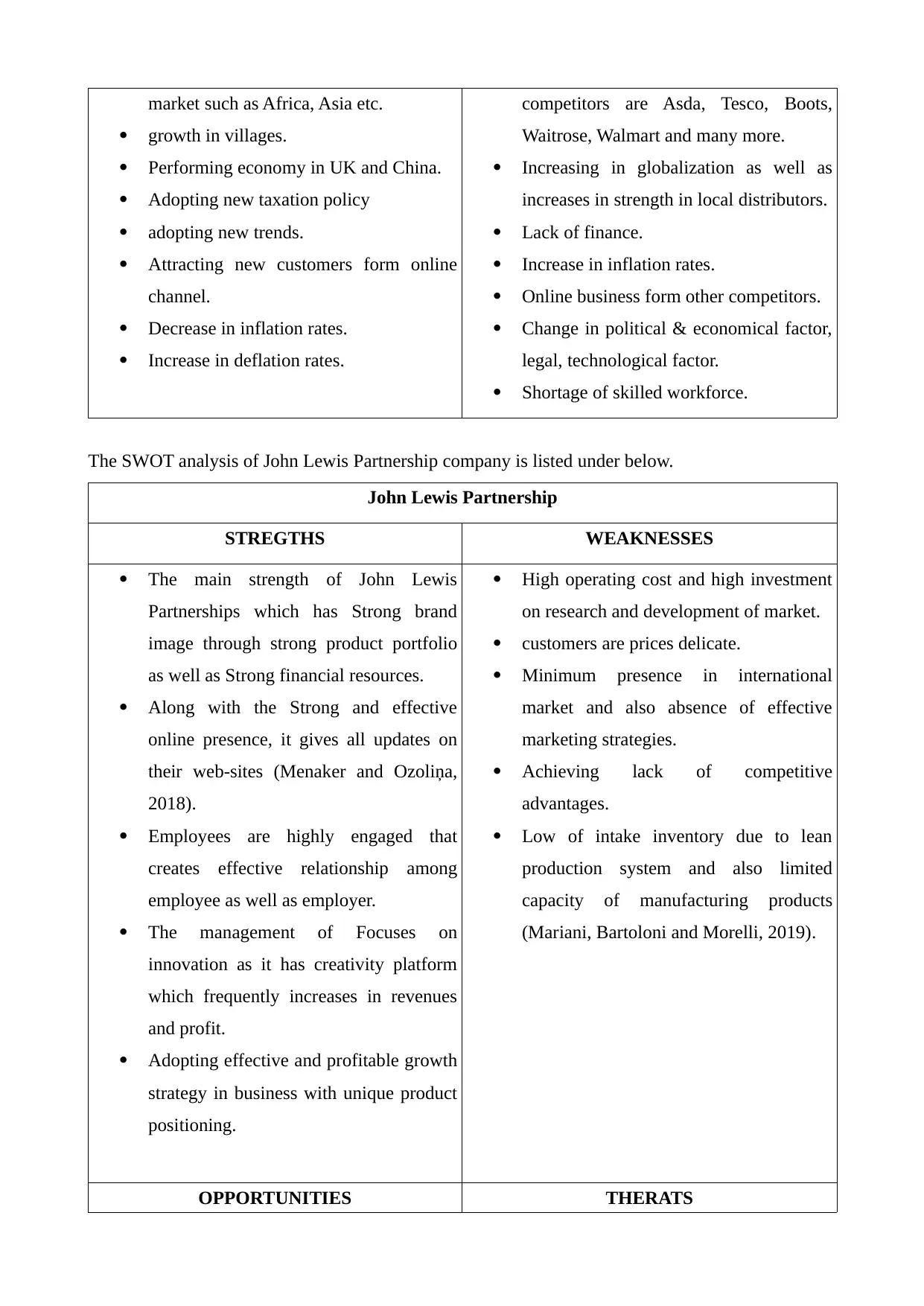
market such as Africa, Asia etc.
growth in villages.
Performing economy in UK and China.
Adopting new taxation policy
adopting new trends.
Attracting new customers form online
channel.
Decrease in inflation rates.
Increase in deflation rates.
competitors are Asda, Tesco, Boots,
Waitrose, Walmart and many more.
Increasing in globalization as well as
increases in strength in local distributors.
Lack of finance.
Increase in inflation rates.
Online business form other competitors.
Change in political & economical factor,
legal, technological factor.
Shortage of skilled workforce.
The SWOT analysis of John Lewis Partnership company is listed under below.
John Lewis Partnership
STREGTHS WEAKNESSES
The main strength of John Lewis
Partnerships which has Strong brand
image through strong product portfolio
as well as Strong financial resources.
Along with the Strong and effective
online presence, it gives all updates on
their web-sites (Menaker and Ozoliņa,
2018).
Employees are highly engaged that
creates effective relationship among
employee as well as employer.
The management of Focuses on
innovation as it has creativity platform
which frequently increases in revenues
and profit.
Adopting effective and profitable growth
strategy in business with unique product
positioning.
High operating cost and high investment
on research and development of market.
customers are prices delicate.
Minimum presence in international
market and also absence of effective
marketing strategies.
Achieving lack of competitive
advantages.
Low of intake inventory due to lean
production system and also limited
capacity of manufacturing products
(Mariani, Bartoloni and Morelli, 2019).
OPPORTUNITIES THERATS
growth in villages.
Performing economy in UK and China.
Adopting new taxation policy
adopting new trends.
Attracting new customers form online
channel.
Decrease in inflation rates.
Increase in deflation rates.
competitors are Asda, Tesco, Boots,
Waitrose, Walmart and many more.
Increasing in globalization as well as
increases in strength in local distributors.
Lack of finance.
Increase in inflation rates.
Online business form other competitors.
Change in political & economical factor,
legal, technological factor.
Shortage of skilled workforce.
The SWOT analysis of John Lewis Partnership company is listed under below.
John Lewis Partnership
STREGTHS WEAKNESSES
The main strength of John Lewis
Partnerships which has Strong brand
image through strong product portfolio
as well as Strong financial resources.
Along with the Strong and effective
online presence, it gives all updates on
their web-sites (Menaker and Ozoliņa,
2018).
Employees are highly engaged that
creates effective relationship among
employee as well as employer.
The management of Focuses on
innovation as it has creativity platform
which frequently increases in revenues
and profit.
Adopting effective and profitable growth
strategy in business with unique product
positioning.
High operating cost and high investment
on research and development of market.
customers are prices delicate.
Minimum presence in international
market and also absence of effective
marketing strategies.
Achieving lack of competitive
advantages.
Low of intake inventory due to lean
production system and also limited
capacity of manufacturing products
(Mariani, Bartoloni and Morelli, 2019).
OPPORTUNITIES THERATS
⊘ This is a preview!⊘
Do you want full access?
Subscribe today to unlock all pages.

Trusted by 1+ million students worldwide
1 out of 18
Related Documents
Your All-in-One AI-Powered Toolkit for Academic Success.
+13062052269
info@desklib.com
Available 24*7 on WhatsApp / Email
![[object Object]](/_next/static/media/star-bottom.7253800d.svg)
Unlock your academic potential
Copyright © 2020–2025 A2Z Services. All Rights Reserved. Developed and managed by ZUCOL.





